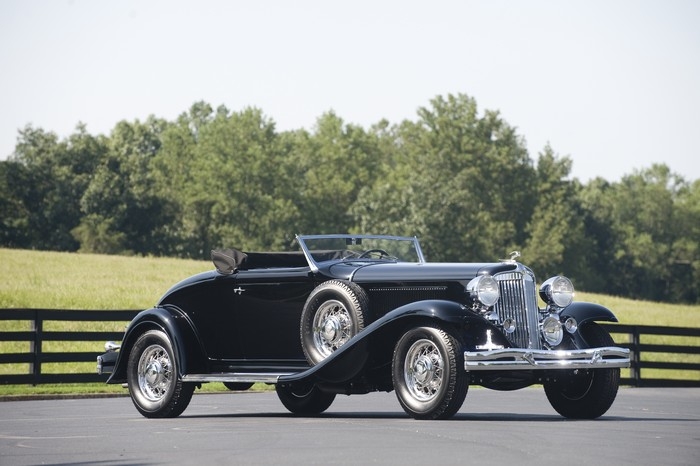The 1932 Chrysler CH Imperial offered by RM is believed to have been the first car to receive a Bohman & Schwartz body. In many ways, it represents a watershed moment in California coachbuilding. While the car could easily have been built on the longer CL Imperial, choosing the 135-inch-wheelbase CH chassis created a design that was taut and sporting.
Painting the Chrysler’s famous Indianapolis-inspired radiator shell and extending the cowl exaggerated the length of the hood. Further emphasizing this aspect of the design was an extremely low raked-back windshield and a snug-fitting top tailored to match, which was combined with a dark finish to give the car a look of unmatched aggression.
SCM Analysis
Detailing
| Vehicle: | 1932 Chrysler CH Imperial Cabriolet |
| Years Produced: | 1931–32 |
| Number Produced: | 1,622 (all 1932 CL |
| Original List Price: | $3,228 |
| SCM Valuation: | $500k–$650k |
| Tune Up Cost: | $450 |
| Distributor Caps: | $200 |
| Chassis Number Location: | Right front door-post hinge |
| Engine Number Location: | Top of timing gear cover |
| Club Info: | Classis Car Club of America |
| Website: | classiccarclub.org |
| Alternatives: | Other coachbuilt cars of its era, including Packard, Duesenberg and Cadillac |
| Investment Grade: | B |
This car, Lot 135, sold for $660,000, including buyer’s premium, at RM’s Monterey auction in Monterey, CA, on August 16, 2013.
In 1926, Chrysler launched the Imperial — the car that Walter P. Chrysler needed to take on Cadillac, Packard and Lincoln in the growing luxury-car field. The new Imperial was the pace car for the 1926 Indianapolis 500, and the new model was stated to have a top speed of 80 miles per hour — quite an achievement for its day.
The Chrysler Imperial was redesigned for 1931 and received a new 384-ci Red Head straight eight engine that produced an impressive 125 horsepower. The new Imperial was referred to as the “Imperial 8,” and the models were an alphabet soup of nomenclature: The CL replaced the CG with a massive 146-inch wheelbase, the CH rode on a 135-inch wheelbase, and the CM retained the 6-cylinder engine with the shorter 116-inch wheelbase.
Bohman & Schwartz
Pasadena new-car dealer Walter M. Murphy had established a reputation for creating custom bodies on Duesenbergs and Lincolns for California’s glamorous movie-star set, but the firm was not immune to the economic realities of the time, and in 1932, it joined the myriad custom coachbuilders to shutter their doors due to the Depression. Maurice Schwartz, a coachbuilding perfectionist at Murphy, joined his friend Christian Bohman, who had left Murphy a few years earlier, and the pair formed Bohman & Schwartz, taking over many of the unfinished Murphy projects.
They built their last automobile in 1941, surviving longer than any other West Coast coachbuilder, having created such well-known customs as the “Topper” car that was modified for later use by the Gilmore Oil Company, and building the 1938 Phantom Corsair designed by Rust Heinz of 57 Varieties fame. They also built the Duesenberg SJ convertibles for Clark Gable and Barbara Hutton.
This car
The 1932 Chrysler CH Imperial Cabriolet offered by RM was stated to be the first custom body conceived by the new firm. It was built to showcase their coachbuilding skills, and it’s a very attractive design. The hood line runs even with the subtly molded beltline of the body, the rear panels around the rumble seat curve smoothly down to the ground, and the windows disappear entirely into the doors, which was very similar to the Murphy-designed convertible coupe built on the Duesenberg Model J chassis.
The initial owner of this custom-designed Chrysler was Lincoln “Stepin Fetchit” Perry — the first African-American actor to become a millionaire. He performed well into the ’70s and continued to own more than a dozen exotic automobiles, this Chrysler among them.
The car passed through at least three additional owners before its two-year restoration began in 1993. During the process, the top and windshield were lowered about three inches, giving it a more sleek appearance than it had originally.
During the restoration, the workers discovered that the woodwork differed on the right and left side of the interior. The owner at the time mentioned in the regional CCCA publication that “Bohman must have worked on the right side of the car, and Schwartz on the left side.”
With the restoration complete, the Chrysler CG Imperial was presented at the 1995 Pebble Beach Concours d’Elegance and was awarded First in Class.
The right money
As offered by RM, the 1932 Chrysler CG Imperial wears an 18-year-old restoration that still appears fresh and is very striking in triple-black livery. When I reviewed it prior to the auction, it was in show-ready condition, but judging standards are far different today than in the mid-’90s, and the altered roof line would create an authenticity issue in current judging circles.
To put this sale in perspective, several custom-bodied Chryslers have recently come to market, including the 1931 CG Imperial Convertible Victoria by Waterhouse that RM sold for $522,500 at their Phoenix sale in January 2012 (ACC# 192663) and the 1932 Imperial CL convertible coupe by LeBaron that they sold at Amelia Island this year for $525,000 (ACC# 215656).
As such, this 1932 CH Imperial, even with its sleeker shorter wheelbase, looks fully priced at this money. But it wasn’t out of line, either — especially considering its status as a “first” for the famed coachbuilding pair and the current heated market for distinguished CCCA Full Classics. Well bought and well sold.
(Introductory description courtesy of RM Auctions.
